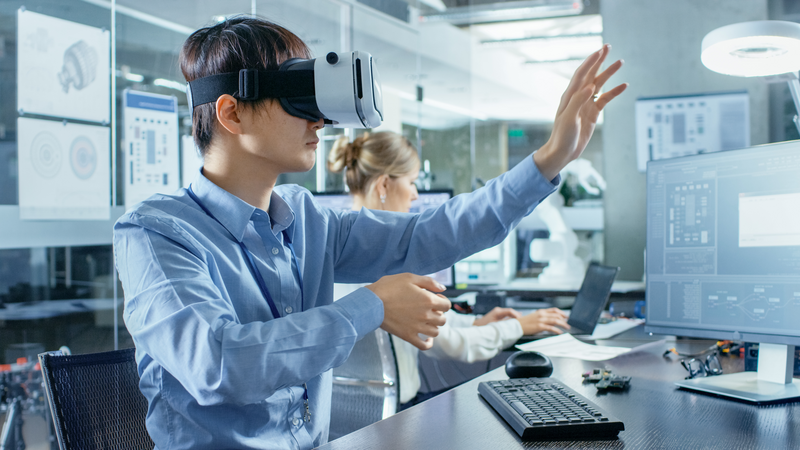ATD Blog
Measuring Learning in the Moment: The KPIs of VR Training
Wed Apr 17 2019

Bookmark
Eighty-seven percent of employees across generations say career development is extremely important to them, yet only 36 percent of those new to the workforce feel they’ve been given the skills and knowledge they need to thrive in their roles.
Companies on the Fortune 500 are quickly realizing that to compete in the war for talent in a business world driven by the pressures of digital transformation, employees must be supported with enhanced learning and development programs. In response, traditional learning models are being replaced with immersive technologies like virtual reality (VR) that equip employees to excel.
The real-world simulation VR creates has been proven to provide behavioral changes in onboarding, training, upskilling, and retention in the workplace. Along with this comes the promise of more data-driven learning for stronger business impact that VR grants.
The Science of Why VR Training Works
In a study by the National Training Laboratory, retention rates for VR learning were 75 percent, which was much higher than those for lecture-style learning (5 percent) and reading (10 percent). With VR training methods, the brain takes in the data to strengthen connections like it would in real life and on the job, critical for driving real-world learning behaviors. Here’s why:
VR technology provides perceptual fidelity that enables learners to benefit from experience. It can replicate situations, giving context with a spatial component. Years of research demonstrates that an engaged learner is a better learner.
VR allows for on-demand repetition training that individuals can take as often as needed for sufficient learning. The ability to assess learners for proficiency at intervals during the training helps further improve their long-term retention.
VR imparts the ability to efficiently and affordably train in “spurts.” Brain science shows that learning is more efficient when short training sessions are spaced out rather than crammed in back-to-back sessions. VR enables the ideal training cadence because it can be used on demand.
VR is effective because it imparts information from organizations to learners in authentic, accessible ways. Learning new skills through VR creates actual muscle memory mentally and physically.
The KPIs of VR Training
“Beyond simply improving how well learners retain information, VR-based training helps learners when they get it wrong. The ability to track all of a trainee’s actions and inputs as he or she moves through a scenario reduces the cost of providing individual feedback and giving tailored feedback.” —Deloitte Insights 2018
But what about learning from the learners? For an L&D program to be successful, the information flow must go both ways. Organizations need to capture data on whether and how learners learn.
In the past, this was a dicey endeavor. With a lecture or video, your assumption (and hope) is that participants were engaged and interacting with the training in a prescribed manner. With the data captured from VR, you no longer have to assume. Using VR headsets, organizations get implicit feedback on user engagement throughout any training session. The VR system, via headset tracking, can pinpoint drifts in attention and other causes of error. VR tracks moment-to-moment behaviors in terms of things like:
usage—training frequency and completion
engagement—interactions and clicks, focus
proficiency—distinguish what they truly know in real world environments; false alarm versus mastery
attention—head movement, eye tracking.
Behavioral data scientists turn that data into digestible insight, so you can identify the training segments that are most successful and the concepts that require learners to spend more time in repetitive lessons.
Engaged learners acquire information better and retain it longer, so being able to assess their engagement is an efficient and effective way to train. You can gauge in the moment what they know and don’t know about real-world decision-making scenarios and gain insight into their reactions and behaviors. Decisions can then be made regarding whether a learner was sufficiently engaged with the training and whether they need to repeat it in the future.
The ability to track engagement also gives organizations the potential to develop adaptive training mechanisms within the experience, to immediately re-engage learners when engagement starts to flag.
Real Results in the Real World
Users consistently rate VR training as “the best training they’ve ever done.” At one of the world’s largest auto manufacturers that, in partnership with STRIVR, has implemented VR as a part of safety and process training, 99 percent of trainees wrote in post-training surveys that they would recommend VR as a method of learning. At Walmart, a STRIVR customer, associates report 30 percent higher satisfaction in their employee training using VR. From manufacturing to retail, workforces across industries are reporting back on both the efficacy and the elevated experience of VR training.
Of course, the KPIs that really matter are the ones that describe employee preparedness once they’re back at the job. VR can produce real-world performance improvements that other methods of learning simply cannot.
For a deeper dive into this topic, please join me at the ATD 2019 International Conference & Exposition for the session, It's Not Hype—It's Happening: VR's Impact on L&D. We will explore different use cases and case studies for successful implementations of VR for learning as well as how to apply a framework for how to think about VR for learning in your own organization.
More from ATD

